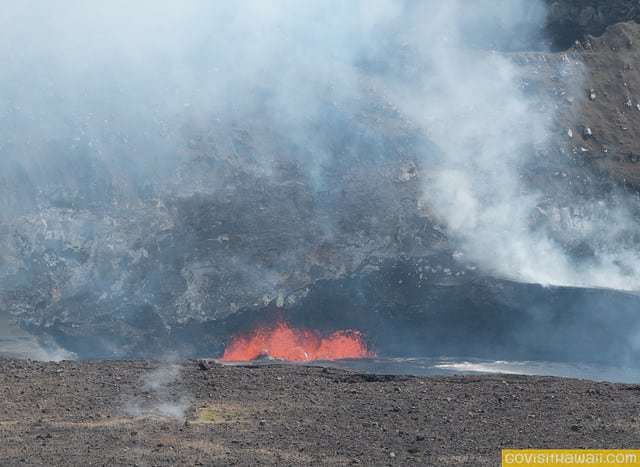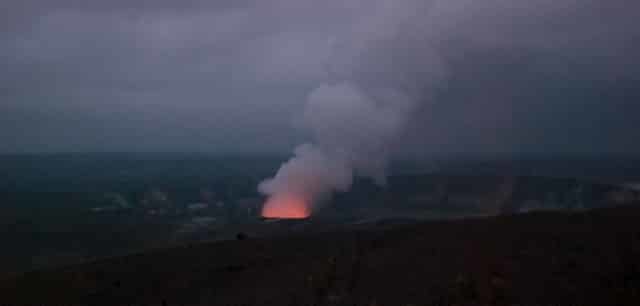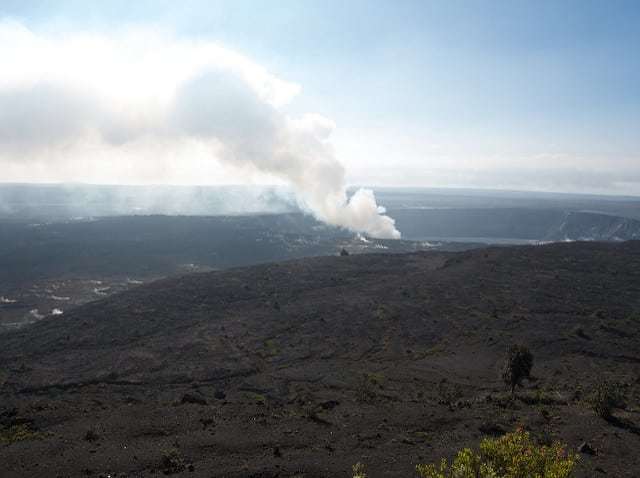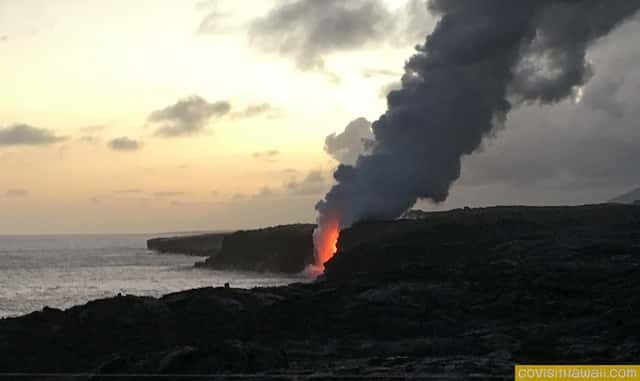
We are sometimes asked about volcanic ash and gases in Hawaii — known as vog. Generally people want to know where the voggy areas are and if vog is an issue that they should be concerned about. In this post we’ll aim to answer those questions and provide you with useful information about vog.
What is vog in Hawaii?
Vog is the term that refers to the hazy air pollution caused by volcanic emissions from Kilauea Volcano on Hawaii (Big) Island. Think of it as volcanic smog, composed of carbon dioxide, sulfur dioxide, water vapor and fine acid particles.

Where does vog come from?
One of main sources of vog is from volcanic vents, when they’re active. Vents emit volcanic gases that originate from below the earth’s surface.

Another source of vog is when lava is flowing to the ocean. The mix of hot lava and much, much cooler water create a plume of gases and steam.
What are the health hazards of vog and who is most at risk?
This USGS page and this page discuss volcanic gases and their health hazards. In short, vog can be an irritant to the eyes, nose, throat and lungs. Visitors to the active volcano areas may experience some irritation in the presence of concentrated vog. Most authorities indicate that the people at most risk for vog-induced health hazards are those with lung problems, infants and young children. Some also say people with heart problems and pregnant women should also be cautious.
From our personal experiences being around Halema’uma’u Crater and by the lava ocean entries where concentrations of vog are higher, we’ve felt our eyes, throats and lungs being slightly irritated. For us, it has been tolerable for short visits and irritation dissipates quickly when we get into fresher air. That tends to be the case for most people.

Where are the biggest areas of concern for vog?
Certainly if you are near the vents or ocean entry plumes on Hawaii Island — especially if the wind is blowing towards you — you will experience higher concentrations of vog. In addition the the crater vents that we’ve already mentioned, the area around Sulphur Banks and Steam Vents in Hawaii Volcanoes National Park is another area with high concentrations of vog.
Problems with vog can literally be based on which way the wind is blowing. Hawaii’s prevailing wind pattern is from the northeast, however, the wind does sometimes blow from the south or southwest. The northerly winds are called trade winds, while the southerly winds are called kona winds. Trade winds blow the volcanic gasses emitted by Kilauea Volcano on Hawaii (Big) Island away from the other Hawaiian islands. When kona winds blow, they send vog towards the other islands, but in much less concentrations than immediately around the volcano vents.
When we’ve been on Maui, Oahu, Lanai, Kauai and even on northern parts of the Big Island when the kona winds push vog to them, we’ve never felt any irritation. A slight haze is visible, but the gases are much less concentrated.
What are other volcanic pollutants in Hawaii?
Laze – steam plume created when molten lava meets the ocean. The hazardous gas in these plumes are hydrochloric acid.
Volcanic ash – tiny rock and glass particles that are primarily generated with rockfalls at volcanic vents. Rockfalls at the vents are rare, so volcanic ash does not generally pose a major health hazard.

How do I know if the air quality is safe?
You can check the sulfur dioxide report for Hawaii on this page — Hawaii Vog Information Dashboard.
Final thoughts about vog in Hawaii
Vog tends to be in high, possibly irritating levels immediately around the volcano activity. We have visited the active volcano sites many times and wouldn’t hesitate to return again and again. Even though Hawaii Island is the only Hawaiian island with an active volcano, we hope to go there many more times.
References and recommended reading:
- Hawaii Interagency Vog Information Dashboard
- Hawaii Volcanoes National Park safety advice page.







4 comments
Is there a certain time of year when the Kona Winds are more prevalent and the Big Island will have less vog? I am allergic to vog.
It’s our understanding that Kona winds are more prevalent in the winter months.
All I want to know is where is a chart that will tell me the air quality o Oahu on a daily basis. Why isnt this easy to find?
Kathryn Rogers
Check the resources in the article under the section “How do I know if the air quality is safe?”